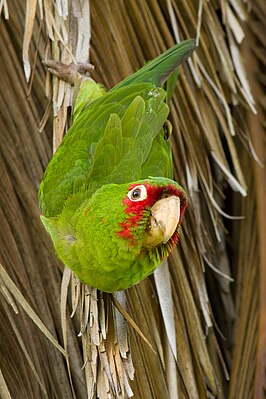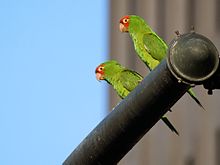Guayaquil Parakeet
| Guayaquil Parakeet | ||||||||||
|---|---|---|---|---|---|---|---|---|---|---|

Guayaquil Parakeet ( Psittacara erythrogenys ) in the Presidio of San Francisco |
||||||||||
| Systematics | ||||||||||
|
||||||||||
| Scientific name | ||||||||||
| Psittacara erythrogenys | ||||||||||
| Lesson , 1844 |
The Guayaquil Parakeet ( Psittacara erythrogenys ) is a medium-sized species of parrot from the genus Psittacara , which is native to western Ecuador and northwestern Peru . Sometimes the Guayaquil is also called the Red- headed Parakeet , but most of the time it refers to another species of parrot, Pyrrhura rhodocephala , from the Red-tailed Parakeet genus .
The parrot, named after Guayaquil , the capital of the Ecuadorian province of Guayas , still appeared there by the thousands in the 1970s. Due to local and international trade and probably also habitat loss, the population of the animals has declined sharply. No flock of more than 200 birds has been observed since 1987.
Outside of Ecuador and Peru, feral descendants of captive refugees occur in Spain , Mexico and the United States . The animals living in San Francisco are the subject of the 2003 documentary The Wild Parrots of Telegraph Hill by Judy Irving .
features
Build and color
Adult Guayaquil Parakeets reach a length of around 33 centimeters. There is no external difference between males and females. The top of the head is red, the dark circles are white and bare. Most of the rest of the body and the wings are green, the belly yellowish. The arm coverts, the outer under wing coverts and the lower thighs are red. The undersides of the wings and the tail are olive-yellow. Juvenile animals largely lack the red color.
Vocalizations
The voice of the Guayaquil parakeet is described as "nasal-squeaking". In flight, especially in a swarm, the animals give out loud screeching calls.
distribution and habitat
The distribution area of the Guayaquil Parakeet extends on the South American Pacific coast in a north-south direction from the province of Manabí in northwest Ecuador to Lambayeque in northwest Peru . In addition, the Guayaquil Parakeet is common in the provinces of Pichincha , Los Ríos , Guayas , Azuay , El Oro and Loja of Ecuador, and in the Tumbes , Piura and Cajamarca regions of Peru. The distribution area extends from sea level to an altitude of 2,500 meters, with most animals being found at an altitude of around 1,500 meters.
The habitats of the Guayaquil Parakeet range from tropical rainforests , through deciduous forests and areas overgrown with acacia bushes, to largely open and dry areas. In addition, the Guayaquil parakeet can be found on the outskirts of cities and in regions that are used intensively for agriculture.
Way of life
nutrition
Little is known about the feeding habits of the Guayaquil Parakeet. The choice of food is probably very dependent on the habitat and the season. The fruits of plants from the families of the sumac family (Anacardiaceae), predatory leaf family (Boraginaceae) and Olacaceae are documented as food for the animals. In south-western Ecuador, Guayaquil parakeets were observed to eat flowers from coral trees when they did not have enough fruit.
Reproduction
The brood takes place in tree hollows (such as Ceiba trischistandra or Cochlospermum vitifolium ) or in termite mounds . In the Tumbes region of Peru , the breeding season begins between March and April and ends in July. In Ecuador, the breeding season extends from January to March. Nests are built 2.5 to 10 meters above the ground, often in natural tree hollows created by fallen branches. The clutch consists of two to four eggs. Captive animals incubate the eggs for an average of 23 days with nestlings leaving the nest six weeks after hatching.
Persistence and Threat

The International Union for Conservation of Nature and Natural Resources (IUCN) classifies the Guayaquil parakeet as "potentially endangered" (NT = near threatened). The populations suffer greatly from local trade in Peru and Ecuador, where the animals are in great demand as pets. However, as with other species of New World parrots , international trade is assumed to be the main cause of the decline in the population . A study published on behalf of the CITES Secretariat in 1992 put the total number of animals exported for the years 1983 to 1988 at nearly 52,000, of which more than 44,000 were in the United States. The loss of habitats through deforestation is assumed to be a further cause of the population decline. However, precise studies of the extent to which the Guayaquil Parakeet is dependent on forests are still pending.
In the United States, captive refugees have reproduced in various cities in California , but the exact size of the populations is unknown.
literature
- N. Collar / P. Boesman / CJ Sharpe: Red-masked Parakeet (Psittacara erythrogenys) , in: Handbook of the Birds of the World Alive, ed. by J. del Hoyo / A. Elliott / J. Sargatal / DA Christie / E. de Juana, Barcelona 2013 (for a fee; last accessed on August 16, 2014).
Web links
- BirdLife Species factsheet
- Psittacara erythrogenys in the endangered Red List species the IUCN 2012. Posted by: BirdLife International, 2012. Accessed August 16, 2014.
Individual evidence
- ↑ a b For this and the following cf. N. Collar / P. Boesman / CJ Sharpe: Red-masked Parakeet (Psittacara erythrogenys) , in: Handbook of the Birds of the World Alive, ed. by J. del Hoyo / A. Elliott / J. Sargatal / DA Christie / E. de Juana, Barcelona 2013 (for a fee; last accessed on August 16, 2014).
- ↑ On this and the following cf. Brinley J. Best / Niels Krabbe / Christopher T. Clarke / Amanda L. Best, Red-masked Parakeet Amtinga erythrogenys and Gray-cheeked Parakeet Brotogeris pyrrhopterus: two threatened parrots from Tumbesian Ecuador and Peru? , in: Bird Conservation International 5, 2-3 (1995), pp. 233-250, here: p. 235, doi: 10.1017 / S0959270900001027 .
- ↑ On this and the following cf. Best [u. a.], Red-masked Parakeet Amtinga erythrogenys and Gray-cheeked Parakeet Brotogeris pyrrhopterus , p. 237.
- ↑ a b c Best [u. a.], Red-masked Parakeet Amtinga erythrogenys and Gray-cheeked Parakeet Brotogeris pyrrhopterus , p. 237.
- ↑ a b Collar, Red-masked Parakeet (Aratinga erythrogenys) , in: Handbook of the Birds of the World Alive, Barcelona 2013.
- ↑ P. Chávez-Riva, Biologia reproductiva y conservación de la Cotorra de Cabeza Roja Aratinga erythrogenic , here quoted from Best [u. a.], Red-masked Parakeet Amtinga erythrogenys and Gray-cheeked Parakeet Brotogeris pyrrhopterus , pp. 237f.
- ↑ a b c d Best [u. a.], Red-masked Parakeet Amtinga erythrogenys and Gray-cheeked Parakeet Brotogeris pyrrhopterus , p. 238.
- ↑ T. Silva, A monograph of macaws and conures , Pickering, Canada 1993, here cited from Best [u. a.], Red-masked Parakeet Amtinga erythrogenys and Gray-cheeked Parakeet Brotogeris pyrrhopterus , p. 238.
- ↑ a b Psittacara erythrogenys , in: The IUCN List of Threatened Species, 2012 (last accessed on August 17, 2014).
- ↑ Tim Inskipp / Harriett Corrigan, A Review of Significant Trade in Animal Species Included in CITES , Appendix II - Detailed Reviews of 24 Priority Species, Geneva 1992, here cited from Best [u. a.], Red-masked Parakeet Amtinga erythrogenys and Gray-cheeked Parakeet Brotogeris pyrrhopterus , p. 239.
- ↑ Cf. Christopher J. Butler, Feral Parrots in the Continental United States and United Kingdom: Past, Present, and Future , in: Journal of Avian Medicine and Surgery, 19, 2 (2005), doi: 10.1647 / 183 , pp. 142-149, here p. 144, and Kimball L. Garrett, Population status and distribution of naturalized parrots in Southern California , in: Western Birds 28, 4 (1997), p. 181-195, here p. 187.